A Review on Improved Design Techniques for High Performance Planar Waveguide Slot Arrays
Abstract
1. Introduction
2. Early Work
3. Waveguide Slot Models
- (a)
- (b)
- (a)
- An interesting work involving modification of the guiding structure was proposed in 1990 by Green et al. [46]. The properties of longitudinal radiating slots in the asymmetric ridge waveguide were investigated. This solution allows for suppressing the butterfly lobes [52], since all the radiating slots are centered with respect to the waveguide axis. Afterward, several configurations of longitudinal slots in the ridged waveguide have been presented, though most have different purposes, such as the RCS reduction of the ridged waveguide slot array using EBG radar absorbing material [53] or the improvement of radiating properties by using a ridged waveguide slot array with a high-impedance ground plane [54], just to cite some examples. However, using a ridged waveguide is not the only way to improve the slot (and slot array) performance. In fact, other valuable solutions are available in the recent literature. For example, in [45], a reconfigurable radiating slot is proposed by means of tuning the screws in the waveguide broad wall opposite to the slot. In [55], the radiating slot was printed in a copper-clad dielectric substrate which replaced the upper waveguide wall and allowed easy and low-cost replacement of the radiating slots when the pattern requirement changed. In [47] a gap waveguide cavity slot array was proposed where the conductor losses were reduced by using the cavity-based radiator with virtual electric walls, which replaced the traditional waveguide slot array. The E-plane waveguide was integrated with the cavity and split from the center broadside, giving robust assembly to the designed array at a low cost. In [48], a slot array antenna based on the use of groove gap waveguide technology was proposed, where glide-symmetric EBG holes instead of pins were used, showing a simpler solution in terms of manufacturing and assembly compared with the use of pins as the unit cell.
- (b)
- In [49] and [50], the radiating element was modified by adding in the external region a truncated waveguide radiating in free space, or a radiating patch, electromagnetically coupled to the waveguide slot. Both of these configurations allow for suppressing the butterfly lobes [52] and increasing the radiating element gain, and they are suitable to allow pressurization of the feeding waveguide. Different radiating characteristics are instead achieved with a slot doublet, which consists of two longitudinal slots cut on the opposite broad walls in the same vertical plane of the radiating waveguide [51,56].
4. Waveguide Slot Arrays
4.1. Analysis and Synthesis of Longitudinal Slot Arrays
4.2. Design of a WSA in a Waveguide Partially Filled with a Dielectric Slab
4.3. Design of a WSA in a Waveguide Covered with a Dielectric Slab
4.4. Multilayer Dielectric Cover Effect in WSAs
4.5. Interaction between the Beam-Forming Network and the Radiating Waveguides
- The strong influence between the T-junction and the coupling slots which connect the radiating and feeding waveguide;
- The interaction between the coupling slot and the nearby radiating slots;
- The effect of the bent terminations.
5. Conclusions
Author Contributions
Funding
Conflicts of Interest
References
- Watson, W.H. The Physical Principles of Waveguide Transmission and Antenna Systems; Clarendon Press: Oxford, UK, 1947. [Google Scholar]
- Elliott, R.S. Antenna Theory and Design; Prentice-Hall: New York, NY, USA, 1981. [Google Scholar]
- Johnson, R.C.; Jasik, H. Antenna Engineering Handbook; McGraw-Hill: New York, NY, USA, 1984. [Google Scholar]
- Casula, G.A.; Mazzarella, G.; Montisci, G. Design of slot arrays in waveguide partially filled with dielectric slab. Electron. Lett. 2006, 42, 730. [Google Scholar] [CrossRef]
- Katehi, P. Dielectric-covered waveguide longitudinal slots with finite wall thickness. IEEE Trans. Antennas Propag. 1990, 38, 1039–1045. [Google Scholar] [CrossRef]
- Casula, G.A.; Montisci, G. Design of Dielectric-Covered Planar Arrays of Longitudinal Slots. IEEE Antennas Wirel. Propag. Lett. 2009, 8, 752–755. [Google Scholar] [CrossRef]
- Jin, Z.; Montisci, G.; Mazzarella, G.; Li, M.; Yang, H.; Casula, G.A. Effect of a multilayer Dielectric Cover on the Behavior of Waveguide Longitudinal Slots. IEEE Antennas Wirel. Propag. Lett. 2013, 11, 1190–1193. [Google Scholar] [CrossRef]
- Orta, R.; Tascone, R.; Zich, R. Performance degradation of dielectric radome covered antennas. IEEE Trans. Antennas Propag. 1988, 36, 1707–1713. [Google Scholar] [CrossRef]
- Hirokawa, J.; Ando, M.; Goto, N. Waveguide-fed parallel plate slot array antenna. IEEE Trans. Antennas Propag. 1992, 40, 218–223. [Google Scholar] [CrossRef]
- Casula, G.A.; Mazzarella, G.; Montisci, G. Design of shaped beam planar arrays of waveguide longitudinal slots. Int. J Antennas Propag. 2013, 2013, 767342. Available online: https://www.hindawi.com/journals/ijap/2013/767342/ (accessed on 21 February 2013). [CrossRef]
- Casula, G.A.; Mazzarella, G. A Direct Computation of the Frequency Response of Planar Waveguide Slot Arrays. IEEE Trans. Antennas Propag. 2004, 52, 1909–1912. [Google Scholar] [CrossRef]
- Casula, G.A.; Mazzarella, G.; Montisci, G. Effect of the feedingT-junctions in the performance of planar waveguide slot arrays. IEEE Antennas Wirel. Propag. Lett. 2012, 11, 953–956. [Google Scholar] [CrossRef]
- Casula, G.A.; Montisci, G.; Mazzarella, G.; Maxia, P.; Fanti, A. Improved analysis of high-performances planar waveguide slot arrays. J. Electromagn. Waves Appl. 2013, 27, 2155–2165. [Google Scholar] [CrossRef]
- Rengarajan, R.S.; Shaw, G.M. Accurate characterization of coupling junctions in waveguide-fed planar slot arrays. IEEE Trans. Microw. Theory Tech. 1994, 42, 2239–2247. [Google Scholar] [CrossRef]
- Schrank, H. Low sidelobe phased array antennas. IEEE Antennas Propag. Soc. Newsl. 1983, 25, 4–9. [Google Scholar] [CrossRef]
- Silver, S. Microwave antenna Theory and Design; Dover Publications: New York, NY, USA, 1965. [Google Scholar]
- Stevenson, A.F. Theory of Slots in Rectangular Wave-Guides. J. Appl. Phys. 1948, 19, 24–38. [Google Scholar] [CrossRef]
- Stegen, R.J. Longitudinal Shunt Slot Characteristics; Technical Report 261; Hughes Technical Memorandum: Culver City, CA, USA, 1971. [Google Scholar]
- Oliner, A.A. The impedance properties of narrow radiating slots in the broad face of rectangular waveguide, Part I theory. IRE Trans. Antennas Propag. 1957, 5, 4–20. [Google Scholar] [CrossRef]
- Yee, Y. Impedance of a Narrow Longitudinal Shut Slot in a Slotted Waveguide Array. IEEE Trans. Antennas Propag. 1974, 22, 589–592. [Google Scholar]
- Khac, T.V.; Carson, C. Impedance properties of a longitudinal slot antenna in the broad face of a rectangular waveguide. IRE Trans. Antennas Propag. 1973, 21, 708–710. [Google Scholar] [CrossRef]
- Elliott, R. An improved design procedure for small arrays of shunt slots. Antennas Propag. Soc. Int. Symp. 2005, 31, 48–53. [Google Scholar] [CrossRef]
- Elliott, R. On the design of traveling-wave-fed longitudinal shunt slot arrays. Antennas Propag. Soc. Int. Symp. 2005, 7, 717–720. [Google Scholar] [CrossRef]
- Elliott, R.; O’Loughlin, W. The design of slot arrays including internal mutual coupling. IEEE Trans. Antennas Propag. 1986, 34, 1149–1154. [Google Scholar] [CrossRef]
- Hansen, R.C.; Brunner, G. Dipole Mutual Impedance for Design of Slot Arrays. Microw. J. 1979, 22, 54–56. [Google Scholar]
- Mazzarella, G.; Panariello, G. On the evaluation of mutual coupling between slots. IRE Trans. Antennas Propag. 1987, 35, 1289–1293. [Google Scholar] [CrossRef]
- Mazzarella, G.; Panariello, G. Design of slot arrays for SAR applications. Alta Freq. 1986, 55, 359–364. [Google Scholar]
- Mazzarella, G.; Panariello, G. Evaluation of edge effects in slot arrays using the geometrical theory of diffraction. IEEE Trans. Antennas Propag. 1989, 37, 392–395. [Google Scholar] [CrossRef]
- Josefsson, L. Mutual coupling calculations including edge effects. Electron. Lett. 1994, 30, 2087–2088. [Google Scholar] [CrossRef]
- Mazzarella, G.; Montisci, G. A Rigorous Analysis of Dielectric-Covered Narrow Longitudinal Shunt Slots with Finite Wall Thickness. Electromagnetics 1999, 19, 407–418. [Google Scholar] [CrossRef]
- Rengarajan, S. Scattering characteristics of a centred-inclined slot in a broad wall of a rectangular waveguide. IEE Proc. H Microw. Antennas Propag. 1990, 137, 343. [Google Scholar] [CrossRef]
- Montisci, G. Design of Circularly Polarized Waveguide Slot Linear Arrays. IEEE Trans. Antennas Propag. 2006, 54, 3025–3029. [Google Scholar] [CrossRef]
- Ferrando-Rocher, M.; Herranz-Herruzo, J.I.; Valero-Nogueira, A. Wideband Coffee-Bean Shaped Radiating Element for Circularly-Polarized Waveguide Slot Arrays. In Proceedings of the 2021 15th European Conference on Antennas and Propagation (EuCAP), Düsseldorf, Germany, 22–26 March 2021; pp. 1–4. [Google Scholar]
- Herranz-Herruzo, J.I.; Ferrando-Rocher, M.; Valero-Nogueira, A.; Bernardo-Clemente, B. Novel Asymmetric T-Shaped Radiating Element for Circularly-Polarized Waveguide Slot Arrays. IEEE Trans. Antennas Propag. 2021. [Google Scholar] [CrossRef]
- Rengarajan, S.R.; Josefsson, L.G.; Elliott, R.S. Waveguide-Fed Slot Antennas and Arrays: A Review. Electromagn. 1999, 19, 3–22. [Google Scholar] [CrossRef]
- Ren, W.; Gao, B.-Q.; Xue, Z.-H.; Li, W.-M.; Liu, B. Full wave analysis of broadwall slot’s character-istics in rectangular waveguides. IEEE Trans. Antennas Propagat. 2004, 52, 2436–2444. [Google Scholar] [CrossRef]
- Montisci, G.; Mazzarella, G. Effect of the Longitudinal Component of the Aperture Electric Field on the Analysis of Waveguide Longitudinal Slots. IEEE Trans. Antennas Propag. 2011, 59, 4334–4337. [Google Scholar] [CrossRef]
- Li, J.L.-W.; Li, L. Smaller offset broadwall longitudinal waveguide slots: A new analysis using a new idea. IEE Proc. Microw. Antennas Propag. 2005, 152, 179. [Google Scholar] [CrossRef]
- Bailey, M. Design of dielectric-covered resonant slots in a rectangular waveguide. IEEE Trans. Antennas Propag. 1967, 15, 594–598. [Google Scholar] [CrossRef]
- Bailey, M.C. The impedance properties of narrow radiating slots on the broad face of a rectangular waveguide. IEEE Trans. Antennas Propagat. 1970, 18, 596–603. [Google Scholar] [CrossRef]
- Rexberg, L. Vector fourier transform analysis of dielectric-covered slot in the broad wall of a waveguide. Microw. Opt. Technol. Lett. 1988, 1, 360–363. [Google Scholar] [CrossRef]
- Mazzarella, G.; Montisci, G. Full-wave analysis of dielectric-covered radiating series slots. Microw. Opt. Technol. Lett. 1999, 20, 67–72. [Google Scholar] [CrossRef]
- Jin, Z.; Montisci, G.; Casula, G.A.; Yang, H.; Lu, J. Efficient evaluation of the external mutual coupling in dielec-tric-covered waveguide slot arrays. Int. J. Antennas Propag. 2012, 2012, 7. [Google Scholar] [CrossRef]
- Amiri, N.; Forooraghi, K. Analysis of a Dielectric-Covered Waveguide Slot Antenna Using the Spectrum of Two-Dimensional Solutions. IEEE Trans. Antennas Propag. 2014, 62, 3818–3823. [Google Scholar] [CrossRef]
- Sanchez-Olivares, P.; Hernandez-Ortega, J.; Masa-Campos, J.L. Mechanically reconfigurable waveguide-slot single element using tuning screws. In Proceedings of the 2017 11th European Conference on Antennas and Propagation (EUCAP), Paris, France, 19–24 March 2017; pp. 1962–1966. [Google Scholar]
- Green, J. Asymmetric Ridge Waveguide Radiating Element for a Scanned Planar Array. IEEE Trans. Antennas Propag. 1990, 1161. [Google Scholar] [CrossRef]
- Li, T.; Boes, F.; Schneider, K.; Zwick, T. Gap-Waveguide Cavity Slot Array Based on Two Metal Layers at 120 GHz. In Proceedings of the 2020 50th European Microwave Conference (EuMC), Utrecht, The Netherlands, 12–14 January 2021; pp. 25–28. [Google Scholar]
- Herrán, L.F.; Brazalez, A.A.; Rajo-Iglesias, E. Ka-band planar slotted waveguide array based on groove gap waveguide technology with a glide-symmetric holey metasurface. Sci. Rep. 2021, 11, 1–9. [Google Scholar] [CrossRef]
- Fakhte, R.; Ghorbaninejad, H. High gain and improved waveguide slot antenna using a metallic superstrate as main radiator. IET Microw. Antennas Propag 2017, 11, 557–563. [Google Scholar] [CrossRef]
- Montisci, G.; Mazzarella, G.; Casula, G.A. Effective Analysis of a Waveguide Longitudinal Slot with Cavity. IEEE Trans. Antennas Propag. 2012, 60, 3104–3110. [Google Scholar] [CrossRef]
- Mondal, P.; Chakrabarty, A. Slotted Waveguide Antenna with Two Radiation Nulls. IEEE Trans. Antennas Propag. 2008, 56, 3045–3049. [Google Scholar] [CrossRef]
- Derneryd, A.G. Butterfly lobes in slotted waveguide antennas. In Proceedings of the 1987 Antennas and Propagation Society International Symposium, Blacksburg, VA, USA, 15–19 June 1987; Volume 25, pp. 360–363. [Google Scholar]
- Li, Y.-Q.; Zhang, H.; Fu, Y.-Q.; Yuan, N.-C. RCS Reduction of Ridged Waveguide Slot Antenna Array Using EBG Radar Absorbing Material. IEEE Antennas Wirel. Propag. Lett. 2008, 7, 473–476. [Google Scholar] [CrossRef]
- Gao, Q. Ridged Waveguide Slot Antenna Using High-Impedance Ground Plane. IEEE Antennas Wirel. Propag. Lett. 2007, 6, 454–456. [Google Scholar] [CrossRef]
- Montisci, G.; Mazzarella, G. Full-Wave Analysis of a Waveguide Printed Slot. IEEE Trans. Antennas Propag. 2004, 52, 2168–2171. [Google Scholar] [CrossRef]
- Sangster, A.; Wang, H. Resonance properties of omnidirectional slot doublet in rectangular waveguide. Electron. Lett. 1993, 29, 16–18. [Google Scholar] [CrossRef]
- Rengarajan, S.R. Compound radiating slots in a broad wall of a rectangular waveguide. IEEE Trans. Antennas Propag. 1989, 37, 1116–1123. [Google Scholar] [CrossRef]
- Hirokawa, J.; Ando, M. 45-deg linearly polarized post-wall waveguide-fed parallel-plate slot arrays. IEE Proc. Microw. Antennas Propag. 2000, 147, 515–519. [Google Scholar] [CrossRef]
- Yamaguchi, H.; Miyashita, T.; Takahashi, T.; Nishino, Y. Design of inclined and displaced slotted waveguide array antennas with low sidelobe radiation patterns. In Proceedings of the Fourth European Conference on Antennas and Propagation, Barcelona, Spain, 12–16 April 2010. [Google Scholar]
- Montisci, G.; Musa, M.; Mazzarella, G. Waveguide Slot Antennas for Circularly Polarized Radiated Field. IEEE Trans. Antennas Propag. 2004, 52, 619–623. [Google Scholar] [CrossRef]
- Kim, Y.; Eom, H. Radiation from Longitudinal Slots on the Narrow Wall of a Rectangular Waveguide. IEEE Antennas Wirel. Propag. Lett. 2008, 7, 641–644. [Google Scholar] [CrossRef]
- Cheng, Y.; Dong, Y. Wideband Circularly Polarized Planar Antenna Array for 5G Millimeter-Wave Applications. IEEE Trans. Antennas Propag. 2021, 69, 2615–2627. [Google Scholar] [CrossRef]
- Xu, H.; Zhou, J.; Zhou, K.; Wu, Q.; Yu, Z.; Hong, W. Planar Wideband Circularly Polarized Cavity-Backed Stacked Patch Antenna Array for Millimeter-Wave Applications. IEEE Trans. Antennas Propag. 2018, 66, 5170–5179. [Google Scholar] [CrossRef]
- Zhang, L. Wideband high-efficiency circularly polarized SIW-fed S-Dipole array for millimeter-wave applications. IEEE Trans. Antennas Propag. 2020, 68, 2422–2427. [Google Scholar] [CrossRef]
- Feng, B.; Lai, J.; Chung, K.L.; Chen, T.-Y.; Liu, Y.; Sim, C.-Y.-D. Communication a compact wideband circularly polarized magnetoelectric dipole antenna array for 5G millimeter-wave applications. IEEE Trans. Antennas Propag. 2020, 68, 6838–6843. [Google Scholar] [CrossRef]
- Chen, M.; Fang, X.-C.; Wang, W.; Zhang, H.-T.; Huang, G.-L. Dual-Band Dual-Polarized Waveguide Slot Antenna for SAR Applications. IEEE Antennas Wirel. Propag. Lett. 2020, 19, 1719–1723. [Google Scholar] [CrossRef]
- Rocher, M.T.; Herranz-Herruzo, J.I.; Valero-Nogueira, A.; Baquerdo-Escudero, M. Dual-Band Single-Layer Slot Array Antenna Fed by K/Ka-Band Dual-Mode Resonators in Gap Waveguide Technology. IEEE Antennas Wirel. Propag. Lett. 2021, 20, 416–420. [Google Scholar] [CrossRef]
- Wada, K.; Tomura, T.; Hirokawa, J. Dual-Polarized 2-D Beam Mode Orthogonal Multiplexing Antenna System for the Nonfar Region. IEEE Trans. Antennas Propag. 2020, 68, 6614–6623. [Google Scholar] [CrossRef]
- Yong, W.Y.; Haddadi, A.; Emanuelsson, T.; Glazunov, A.A. A Bandwidth-Enhanced Cav-ity-Backed Slot Array Antenna for mmWave Fixed-Beam Applications. IEEE Antennas Wirel. Propag. Lett. 2020, 19, 1924–1928. [Google Scholar] [CrossRef]
- Miura, Y.; Hirokawa, J.; Ando, M.; Shibuya, Y.; Yoshida, G. Double-Layer Full-Corporate-Feed Hollow-Waveguide Slot Array Antenna in the 60-GHz Band. IEEE Trans. Antennas Propag. 2011, 59, 2844–2851. [Google Scholar] [CrossRef]
- Shi-Gang, Z.; Guan-Long, H.; Zhao-Hang, P.; Ying, L.-J. A Wideband Full-Corporate-Feed Waveguide Slot Planar Array. IEEE Trans. Antennas Propag. 2016, 64, 1974–1978. [Google Scholar] [CrossRef]
- Farahbakhsh, A.; Zarifi, D.; Zaman, A.U. A mmWave Wideband Slot Array Antenna Based on Ridge Gap Waveguide With 30% Bandwidth. IEEE Trans. Antennas Propag. 2017, 66, 1008–1013. [Google Scholar] [CrossRef]
- Zhao, H.; Lu, Y.; You, Y.; You, Q.; Wang, Y.; Yang, W.-W.; Huang, J. E-Band Full Corpo-rate-Feed 32× 32 Slot Array Antenna with Simplified Assembly. IEEE Antennas Wirel. Propag. Lett. 2021, 20, 518–522. [Google Scholar] [CrossRef]
- Zarifi, D.; Farahbakhsh, A.; Zaman, A.U.; Kildal, P.-S. Design and Fabrication of a High-Gain 60-GHz Corrugated Slot Antenna Array with Ridge Gap Waveguide Distribution Layer. IEEE Trans. Antennas Propag. 2016, 64, 2905–2913. [Google Scholar] [CrossRef]
- Kim, D.; Hirokawa, J.; Ando, M.; Takeuchi, J.; Hirata, A. 64 × 64-element and 32 × 32-element slot array antennas using double-layer hollow waveguide corporate-feed in the 120 GHz band. IEEE Trans. Antennas Propag. 2014, 62, 1507–1512. [Google Scholar] [CrossRef]
- Wu, Y.F.; Cheng, Y.J.; Yao, S.S.; Fan, Y. Millimeter-Wave Near-Field-Focused Full 2-D Frequency Scanning Antenna Array With Height-Modulated-Ridge Waveguide. IEEE Trans. Antennas Propag. 2021, 69, 2595–2604. [Google Scholar] [CrossRef]
- Sanchez-Escuderos, D.; Herranz-Herruzo, J.I.; Ferrando-Rocher, M.; Valero-Nogueira, A. True-Time-Delay Mechanical Phase Shifter in Gap Waveguide Technology for Slotted Waveguide Arrays in Ka-Band. IEEE Trans. Antennas Propag. 2021, 69, 2727–2740. [Google Scholar] [CrossRef]
- Hamadallah, M. Frequency limitations on broad-band performance of shunt slot arrays. IEEE Trans. Antennas Propag. 1989, 37, 817–823. [Google Scholar] [CrossRef]
- Coetzee, J.; McNamara, D.; Joubert, J. Off-center-frequency analysis of a complete planar slotted-waveguide array consisting of subarrays. IEEE Trans. Antennas Propag. 2000, 48, 1746–1755. [Google Scholar] [CrossRef]
- Kedar, A.; Revankar, U.K. Parametric study of flat sandwich multilayer radome. Prog. Electromagn. Res. 2006, 66, 253–265. [Google Scholar] [CrossRef][Green Version]
- Montisci, G.; Jin, Z.; Li, M.; Yang, H.; Casula, G.A.; Mazzarella, G.; Fanti, A. Design of Multilayer Dielectric Cover to Enhance Gain and Efficiency of Slot Arrays. Int. J. Antennas Propag. 2013, 2013, 1–6. [Google Scholar] [CrossRef]
- Trentini, G.V. Partially reflecting sheet arrays. IRE Trans. Antennas Propag. 1956, 4, 666–671. [Google Scholar] [CrossRef]
- Coetzee, J.C.; Sheel, S. Waveguide Slot Array Design with Compensation for Higher Order Mode Coupling Between Inclined Coupling Slots and Neighboring Radiating Slots. IEEE Trans. Antennas Propag. 2019, 67, 378–389. [Google Scholar] [CrossRef]
- Atamanesh, M.; Zahedi, A.; Abbasi-Arand, B. Design, Simulation, and Fabrication of a High-Gain Low-Sidelobe-Level Waveguide Slot Array Antenna at X-Band with Zero Beam Tilts in Both Azimuth and Elevation Directions. IEEE Antennas Wirel. Propag. Lett. 2020, 19, 811–815. [Google Scholar] [CrossRef]
- Wang, A.; Li, X.; Zhao, J.; Yi, X.; Yang, L.; Zhang, Y. Low sidelobe level circularly polarised monopulse slot waveguide antenna array for Ka-band application. IET Microw. Antennas Propag. 2020, 14, 1919–1925. [Google Scholar] [CrossRef]
- Vosoogh, A.; Haddadi, A.; Zaman, A.U.; Yang, J.; Zirath, H.; Kishk, A.A. WW -Band Low-Profile Monopulse Slot Array Antenna Based on Gap Waveguide Corporate-Feed Network. IEEE Trans. Antennas Propag. 2018, 66, 6997–7009. [Google Scholar] [CrossRef]
- Zhang, M.; Hirokawa, J.; Ando, M. A Four-Corner-Fed Double-LayerWaveguide Slot ArrayWith Low Sidelobes Developed for a 40 GHz-Band DDD System. IEEE Trans. Antennas Propag. 2016, 64, 2005. [Google Scholar] [CrossRef]
- Mazzarella, G.; Montisci, G. Wideband Equivalent Circuit of a Centered-Inclined Waveguide Slot Coupler. J. Electromagn. Waves Appl. 2000, 14, 133–151. [Google Scholar] [CrossRef]
- Casula, G.A.; Mazzarella, G.; Montisci, G. Effective Analysis of a Microstrip Slot Coupler. J. Electromagn. Waves Appl. 2004, 18, 1203–1217. [Google Scholar] [CrossRef]
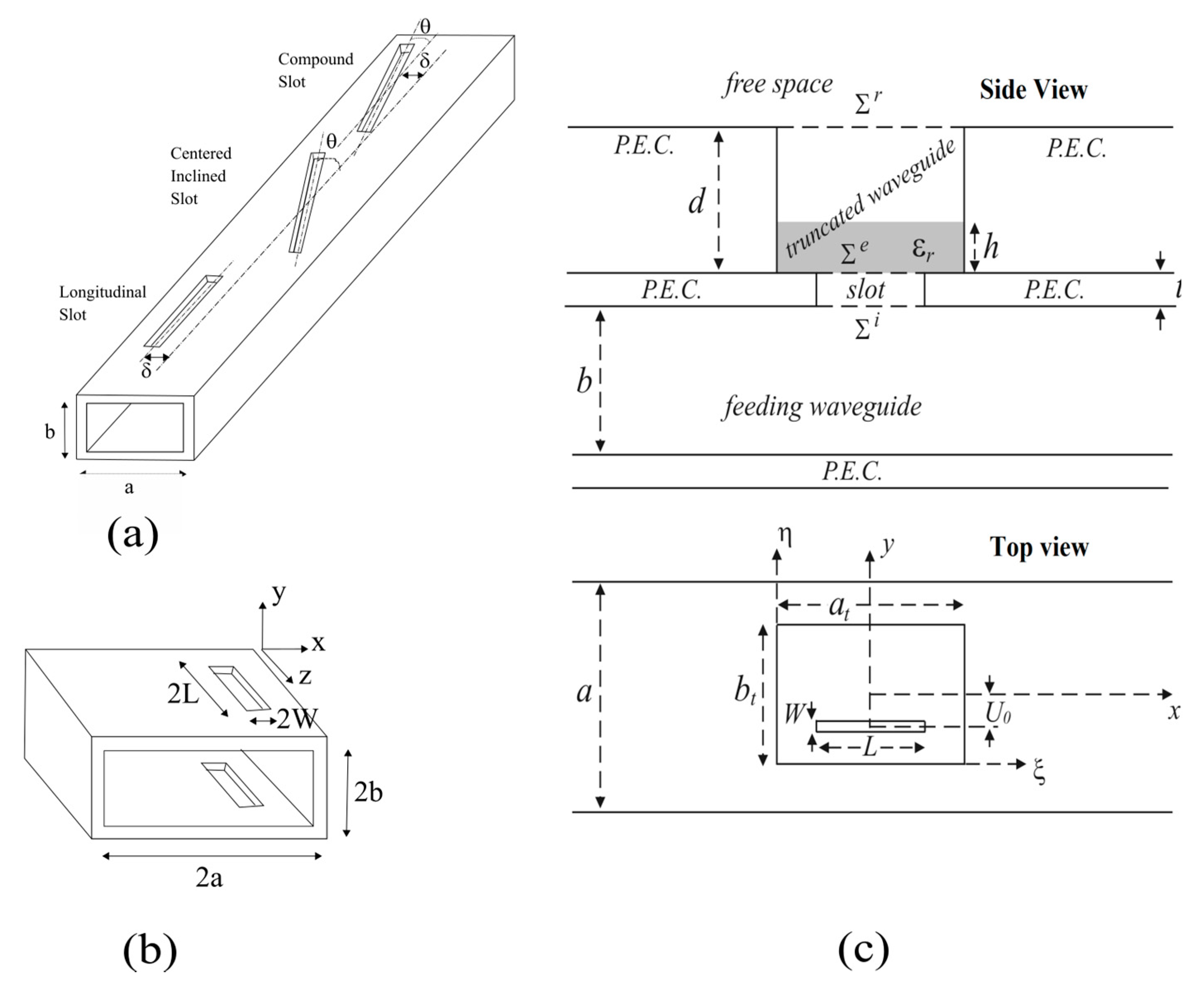

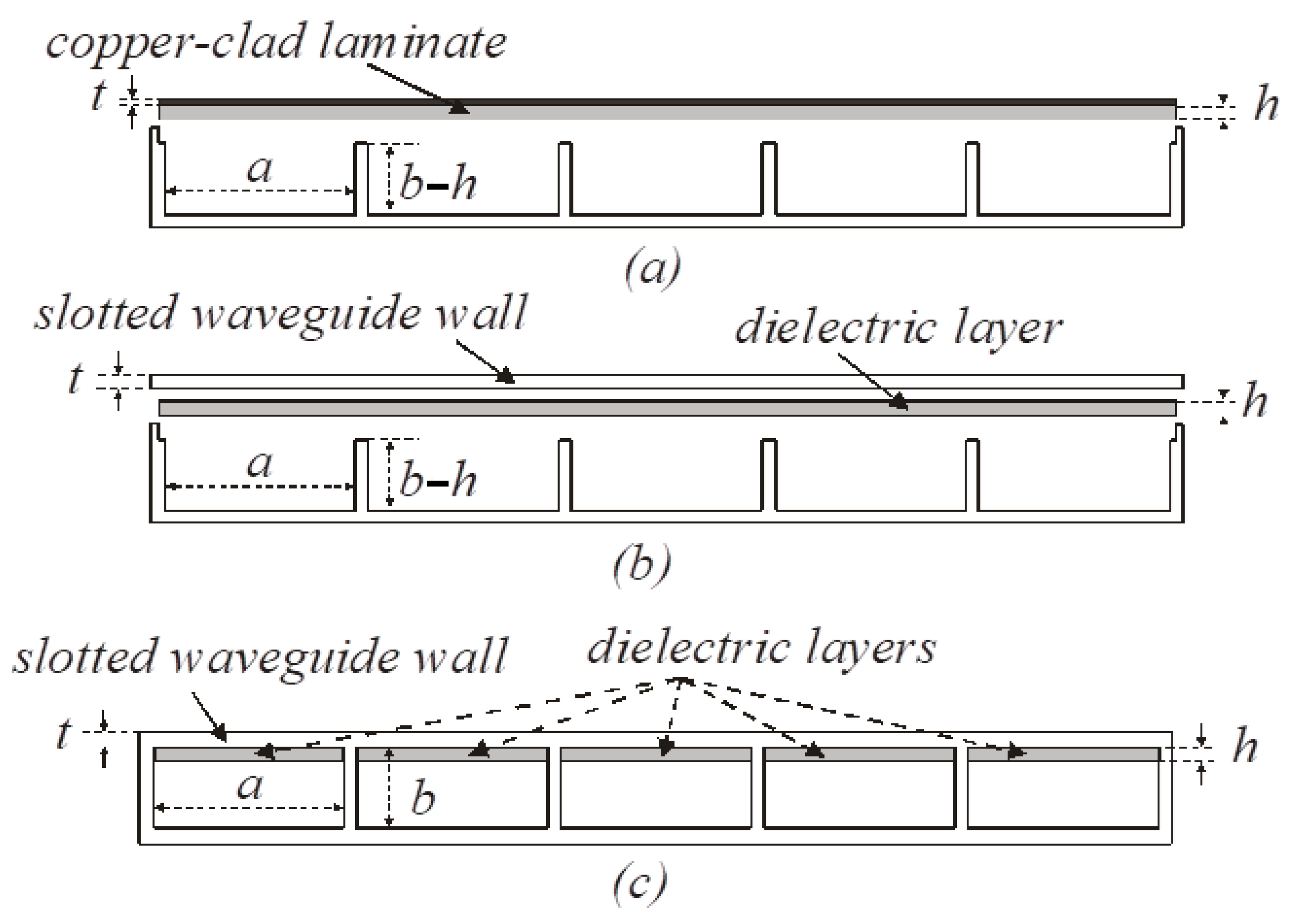
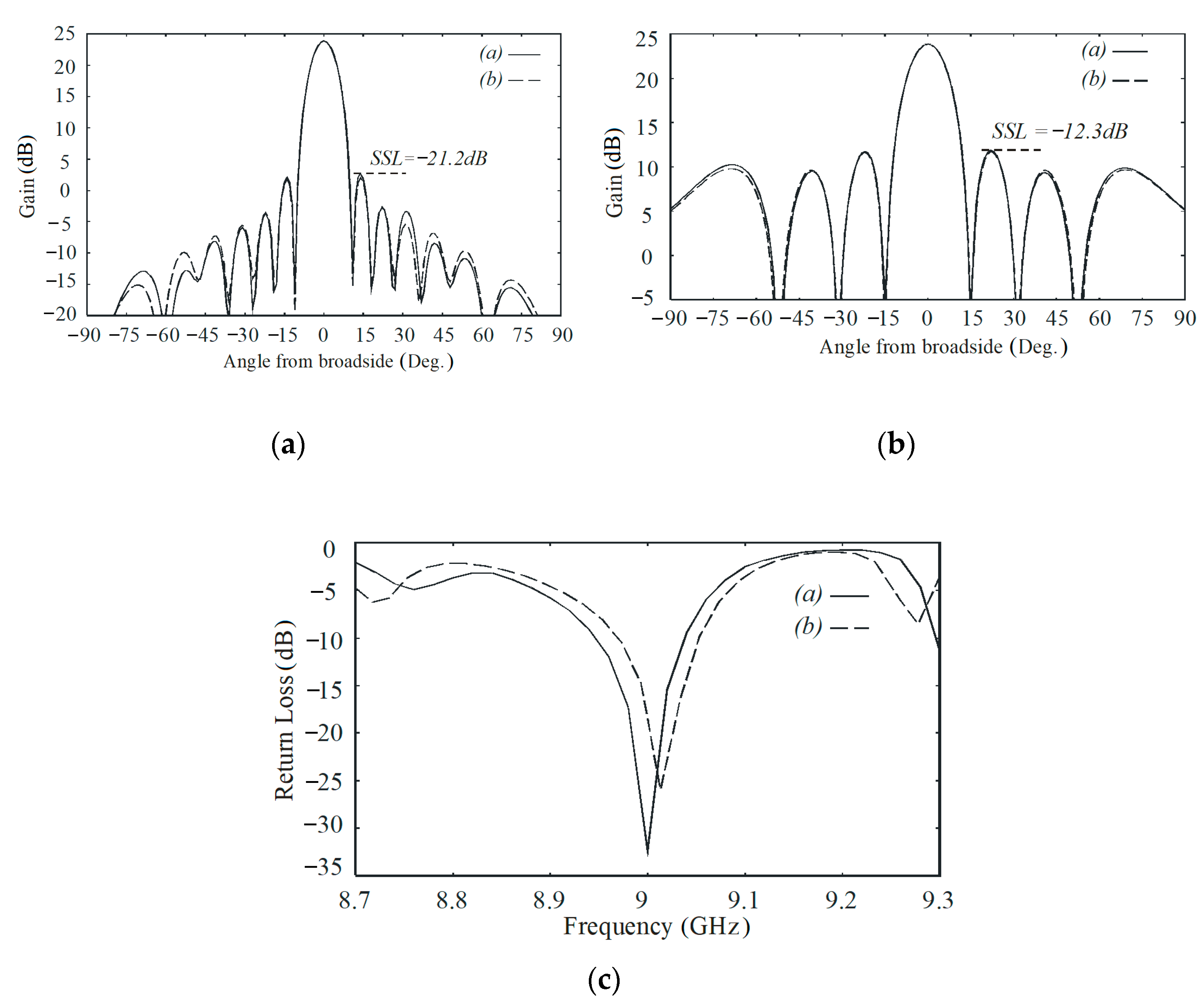

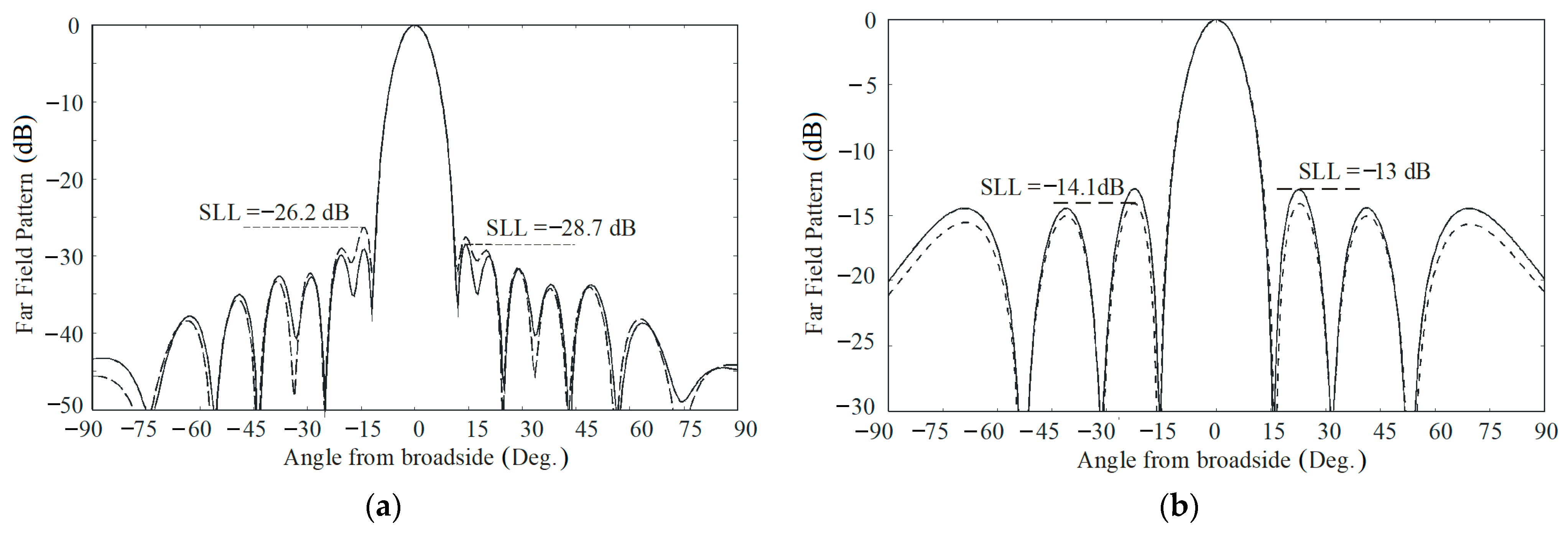

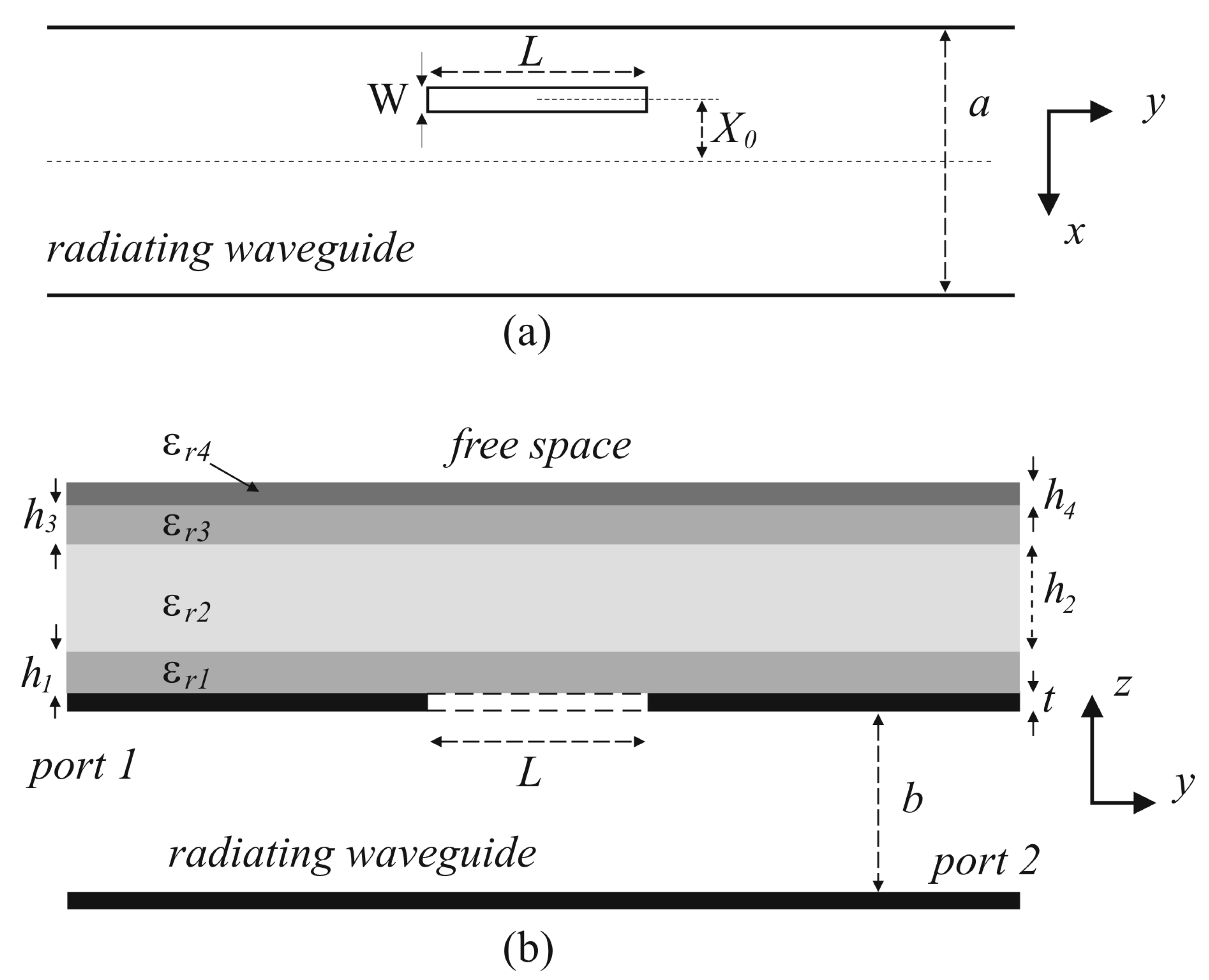
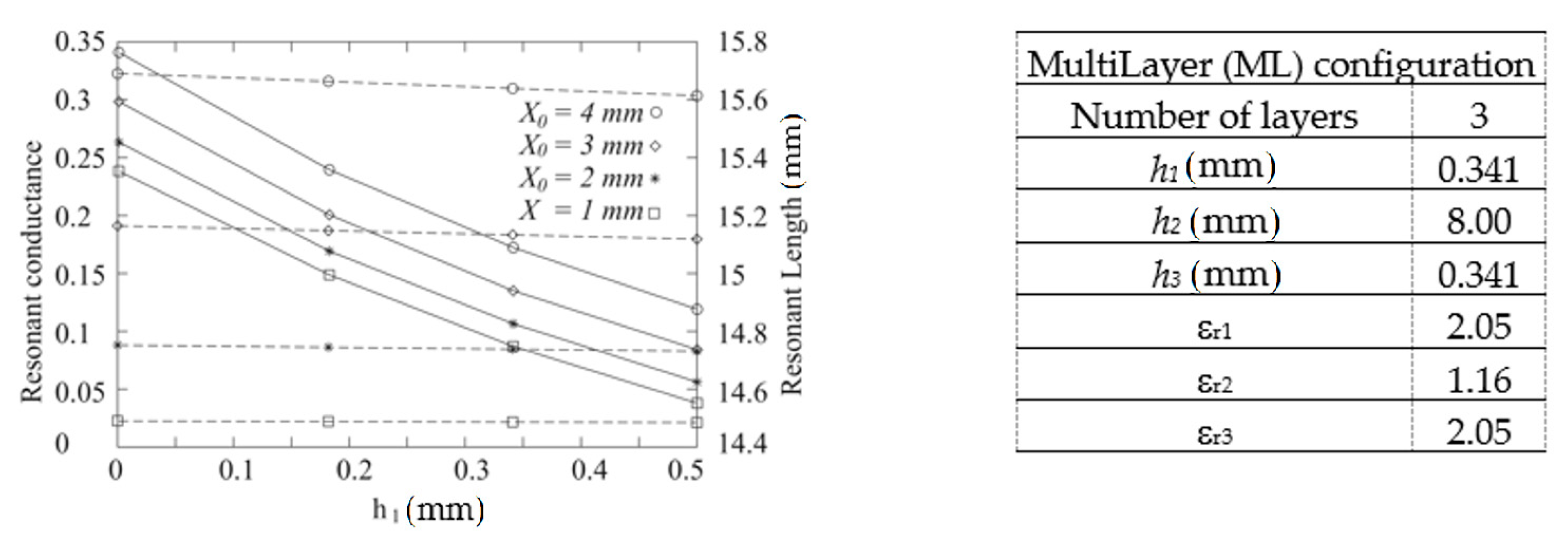


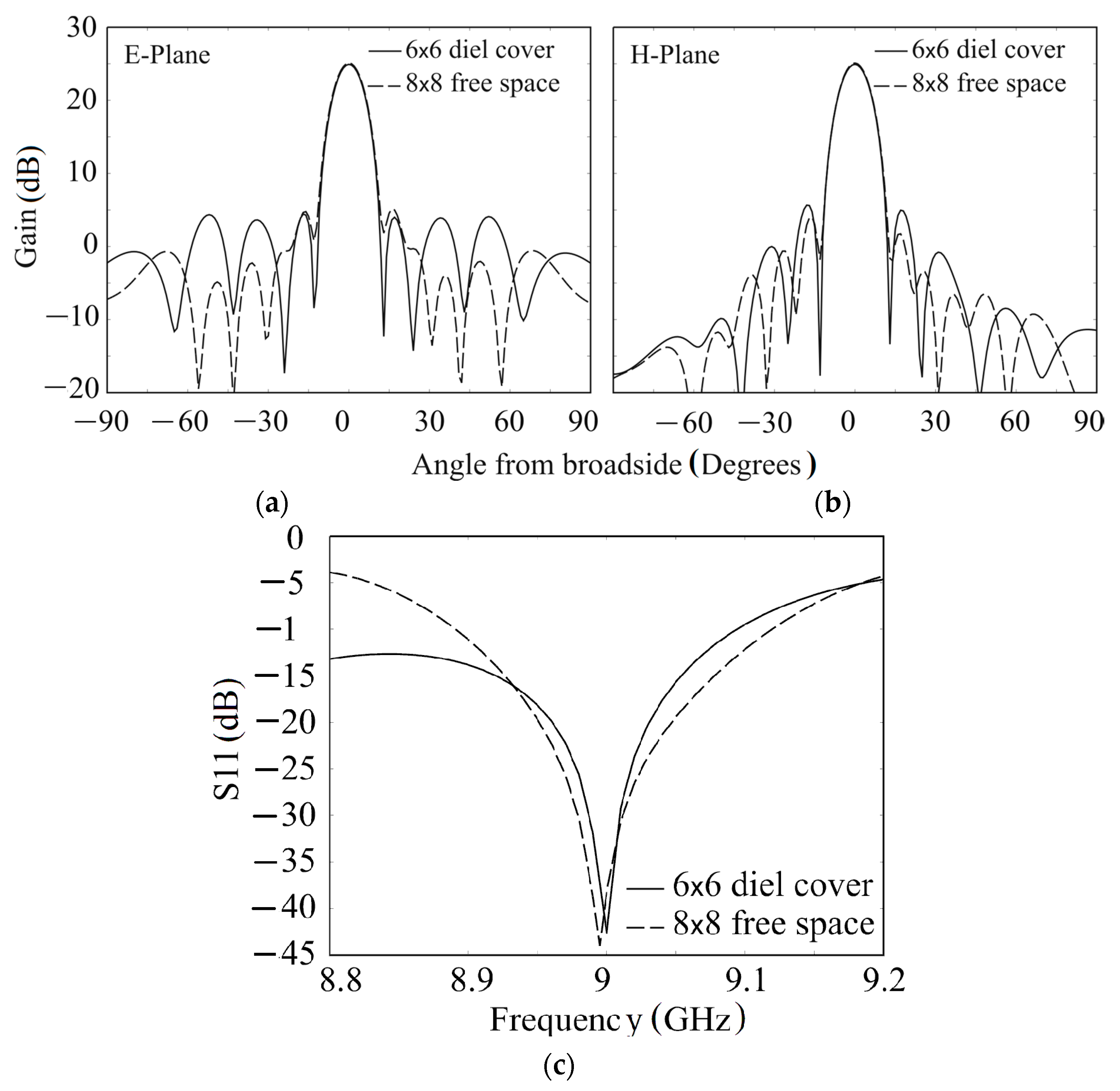
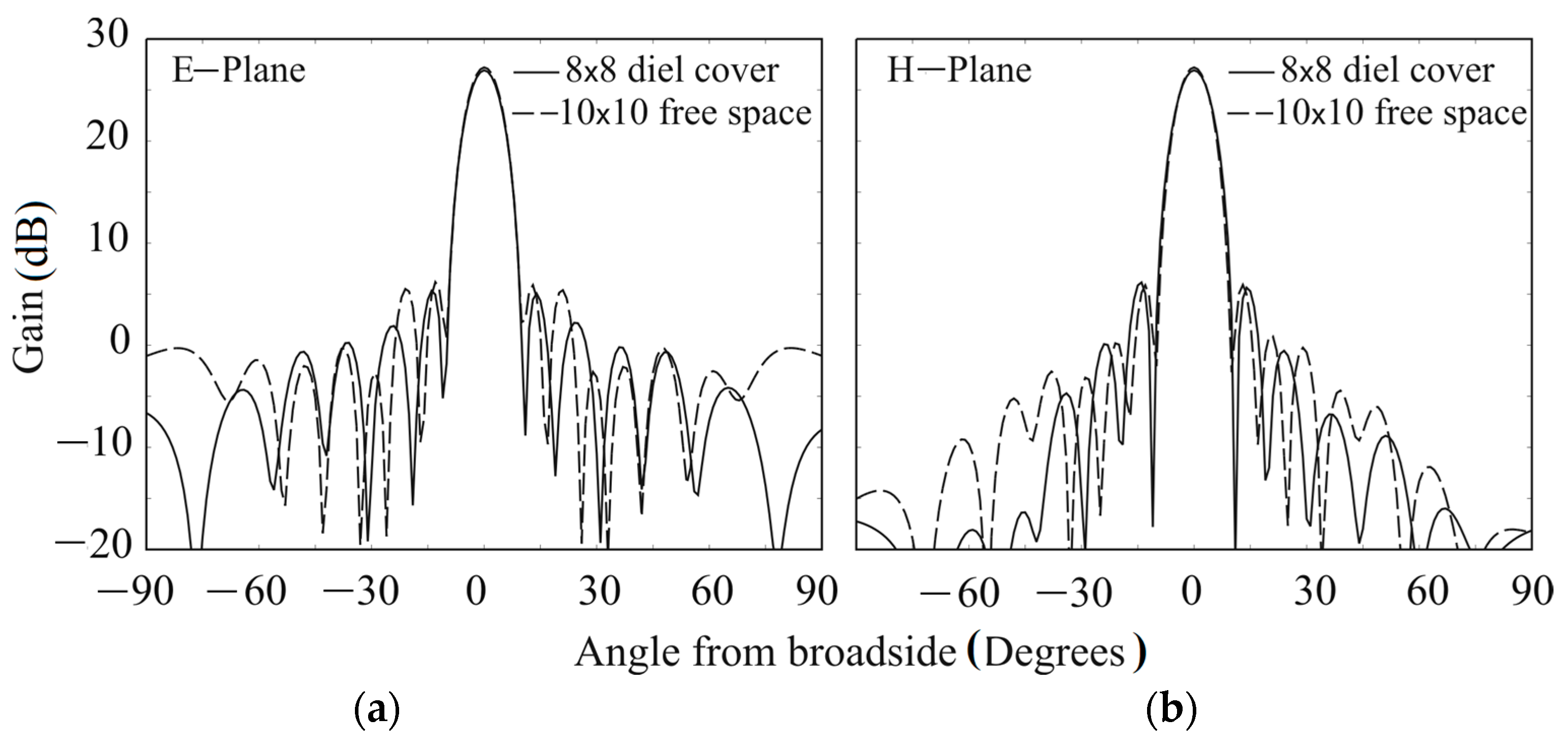
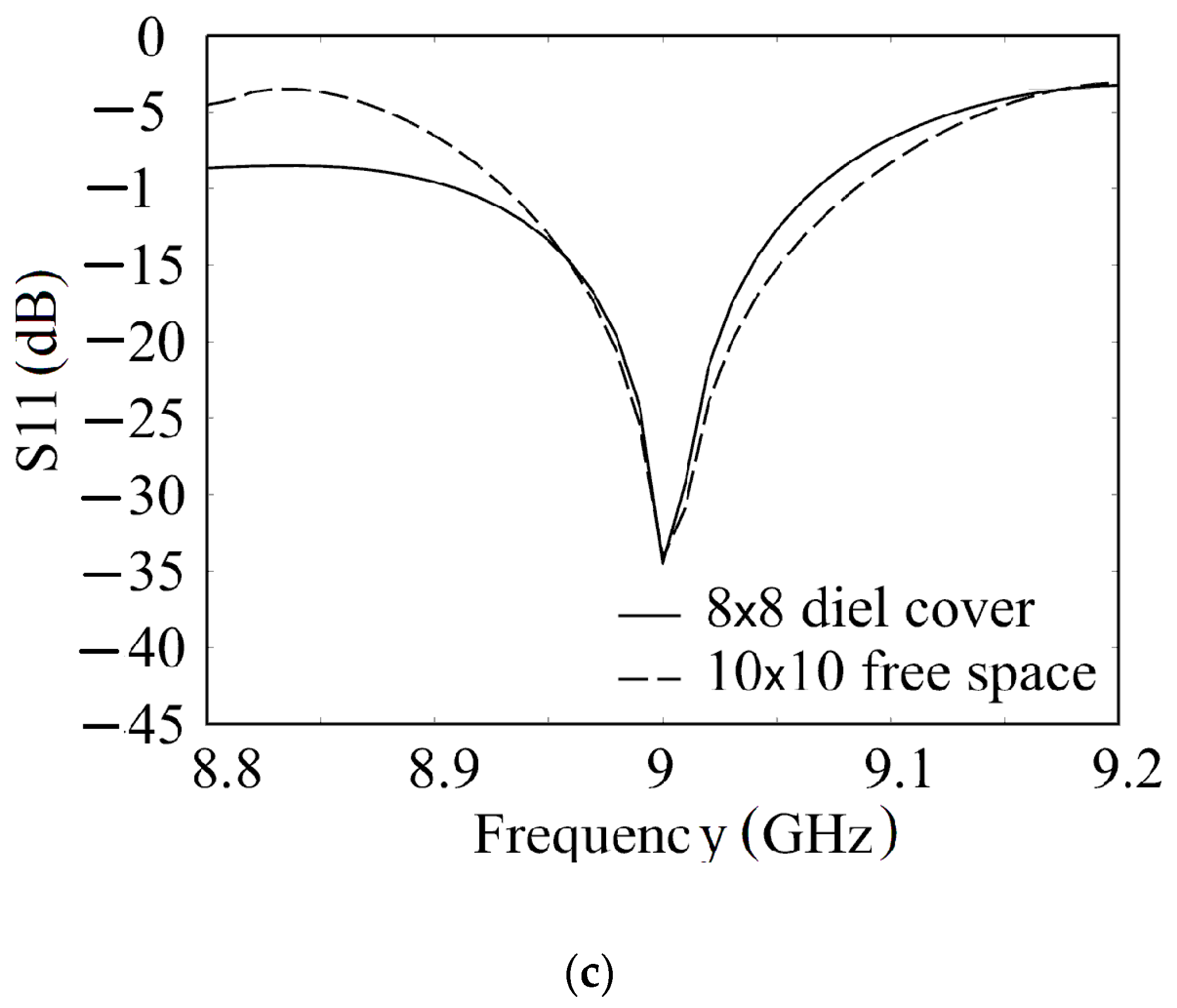
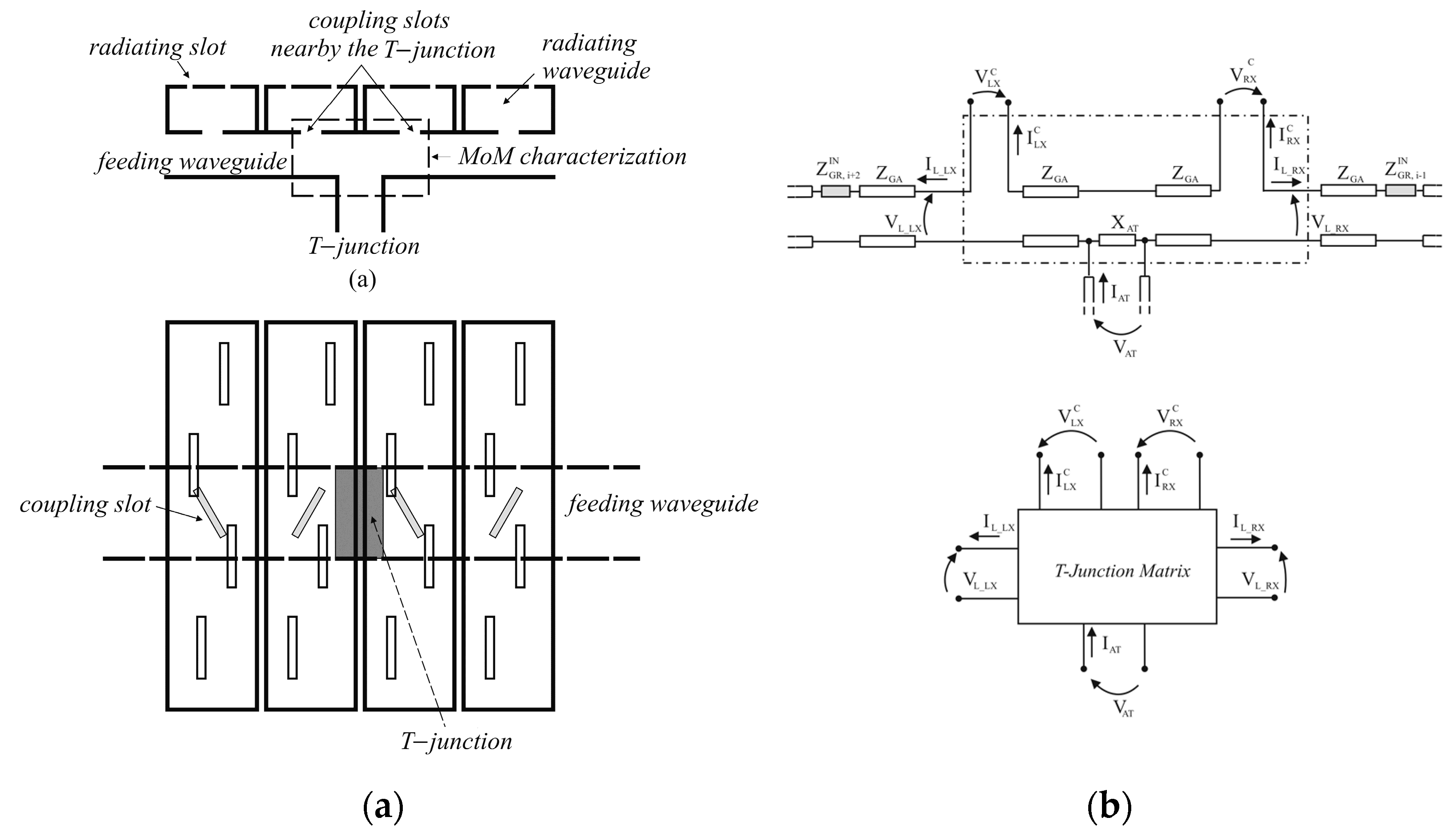
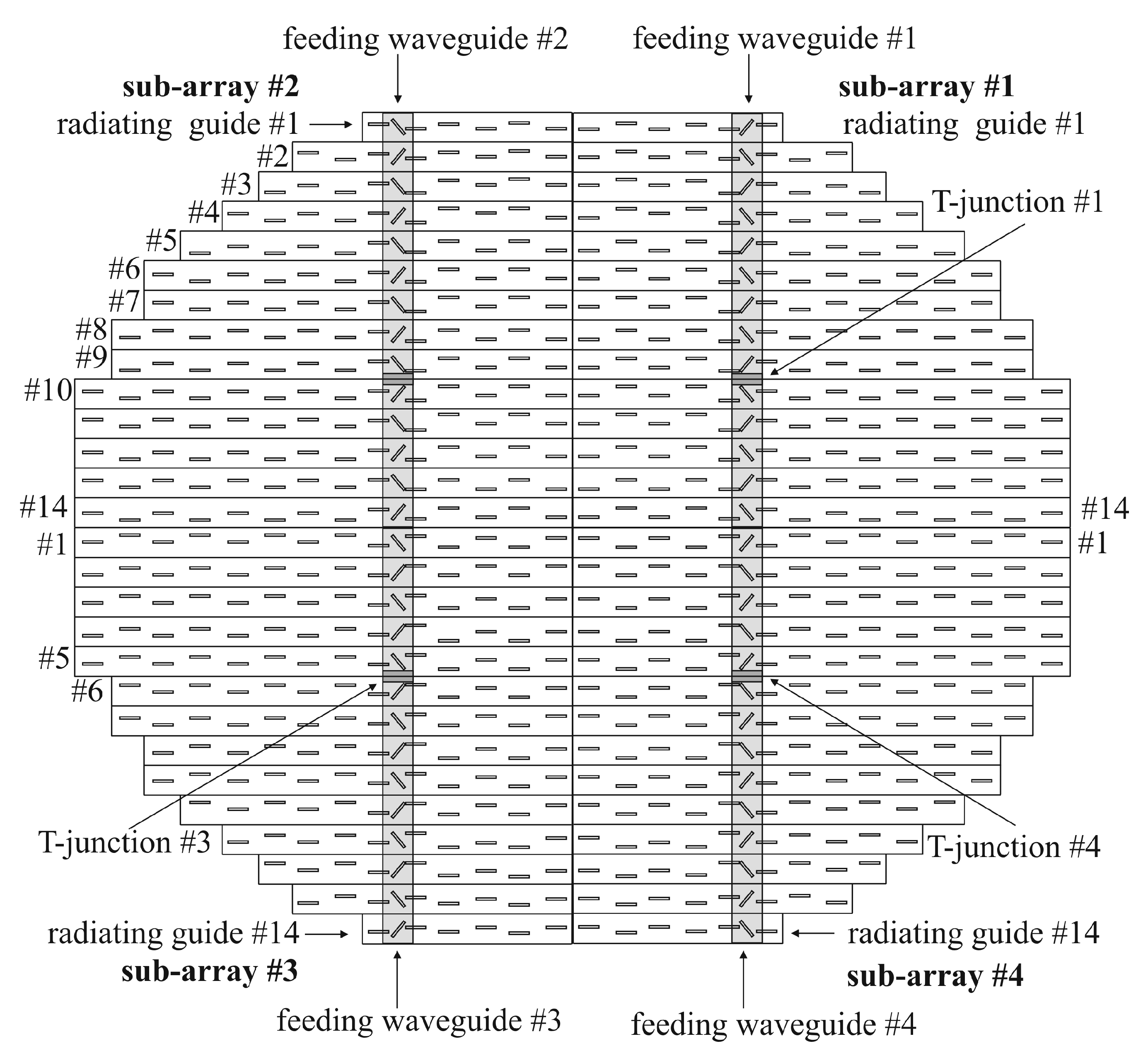

| Advantages of WSAs | Drawbacks of WSAs |
|---|---|
| Low power dissipation and low losses | Small, useful bandwidth (resonant antennas) |
| High mechanical strength | High realization cost |
| Massive realization | Low flexibility |
| Small size | Weak reconfigurability |
| Easily unfoldable | - |
| High power handling capability | - |
| High radiation efficiency | - |
| Advantages | |||||
|---|---|---|---|---|---|
| WSA Configuration | Pressurization | Thermal Insulation | Gain Enhancement | Aerodynamic Purposes | Flexibility |
| Standard WSA | - | - | - | - | - |
| WSA with waveguides covered with dielectric slab | Yes | Yes | - | Yes | Yes |
| WSA with waveguides partially filled with dielectric slab | Yes | - | - | - | Yes |
| WSA with multilayer dielectric cover | Yes | Yes | Yes | Yes | Yes |
| Ref. | Freq (GHz) | No. of Elements | Aperture Size (λ02) | RLBW (−10 dB) | ARBW (3 dB) | GBW (3 dB) | PG | η | SLL (dB) |
|---|---|---|---|---|---|---|---|---|---|
| [34] | 30 | 10 × 1 | 0.9 × 6 | 4% | 8% | 4% | 16.3dBi | 98% | −18.5 |
| [47] | 120 | 8 × 8 | 5.67 × 5.67 | 13.3% | - | 13.3% | 25 dBi | 75% | −13 |
| [48] | 28.6 | 4 × 9 | 4.3 × 8.6 | 7% | - | 7% | 24.8 dBi | 75% | −11.5 |
| [62] | 30 | 4 × 4 | 3.5 × 3.5 | 40.21% | 36.51% | 37.02% | 19 dBic | - | −13 |
| [63] | 29 | 4 × 4 | 10.25 × 8.7 | 29.6% | 25.4% | 19% | 20.3 dBic | 57.9% | −10 |
| [64] | 30 | 8 × 8 | 6.12 × 6.12 | 27.6% | 32.7% | 30% | 25.2 dBic | 75.2% | −13 |
| [65] | 28 | 4 × 4 | 7 × 5 | 27.7% | 27.8% | 25.3% | 20.2 dBic | 78% | −10 |
| [69] | 28 | 8 × 8 | 7.6 × 7.6 | 28% | - | 25.2% | 26.4 dBi | 60% | −13 |
| [70] | 60 | 16 × 16 | 15.4 × 15.6 | 11.4% | - | 11% | 33.5 dBi | 83.6% | −14.9 |
| [71] | 12 | 8 × 8 | 7.4 × 7.4 | 36.9% | - | 31.9% | 23.4 dBi | 60% | −21.3 |
| [72] | 60 | 8 × 8 | 7.6 × 6.9 | 30% | - | 29.1% | 27.5 dBi | 80% | - |
| [73] | 78.5 | 32 × 32 | 29.56 × 29.56 | 19% | - | 19% | 38.4 dBi | 76.4% | −13 |
| [74] | 62 | 16 × 16 | 7 × 6.4 | 16% | - | 16% | 32.5 dBi | 70% | −13 |
| [75] | 130 | 32 × 32 | 30.43 × 30.43 | 12% | - | 12% | 38 dBi | 60% | −13 |
| [81] | 9 | 8 × 8 | 5.92 × 7.8 | 2% | - | 2% | 27.1 dBi | 67% | −20 |
| [84] | 9.3 | 64 × 24 | 55.8 × 17 | 4.3% | - | 4.3% | 37.7 dBi | 50% | −22.5 |
| [85] | 35 | 22 × 1 | 22.68.57 × 2.92 | 3.7% | 3.7% | 3.7% | 23.3 dBic | 75% | −28 |
| [86] | 94 | 16 × 16 | 17.23 × 17.23 | 21% | - | 21% | 30.5 dBi | 60% | −20 |
| [87] | 40 | 22 × 20 | 17.23 × 17.23 | 3.75% | - | 3.75% | 31.8 dBi | - | −30 |
Publisher’s Note: MDPI stays neutral with regard to jurisdictional claims in published maps and institutional affiliations. |
© 2021 by the authors. Licensee MDPI, Basel, Switzerland. This article is an open access article distributed under the terms and conditions of the Creative Commons Attribution (CC BY) license (https://creativecommons.org/licenses/by/4.0/).
Share and Cite
Casula, G.A.; Mazzarella, G.; Montisci, G.; Muntoni, G. A Review on Improved Design Techniques for High Performance Planar Waveguide Slot Arrays. Electronics 2021, 10, 1311. https://doi.org/10.3390/electronics10111311
Casula GA, Mazzarella G, Montisci G, Muntoni G. A Review on Improved Design Techniques for High Performance Planar Waveguide Slot Arrays. Electronics. 2021; 10(11):1311. https://doi.org/10.3390/electronics10111311
Chicago/Turabian StyleCasula, Giovanni Andrea, Giuseppe Mazzarella, Giorgio Montisci, and Giacomo Muntoni. 2021. "A Review on Improved Design Techniques for High Performance Planar Waveguide Slot Arrays" Electronics 10, no. 11: 1311. https://doi.org/10.3390/electronics10111311
APA StyleCasula, G. A., Mazzarella, G., Montisci, G., & Muntoni, G. (2021). A Review on Improved Design Techniques for High Performance Planar Waveguide Slot Arrays. Electronics, 10(11), 1311. https://doi.org/10.3390/electronics10111311








